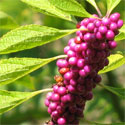Managing Forests for Wildlife
Habitat is an area that contains all the resources a particular species of animal needs to survive and reproduce. The three primary resources all animals require are food, cover (shelter), and water. Because different species of animals require different sources of food and different types of cover, an area that provides high quality habitat for one species may provide poor quality habitat for another. Therefore, no forest stand can provide habitat for all species of wildlife. Forest land owners and land managers interested in promoting wildlife need to prioritize which species they want to encourage in each section of land before they begin planning forest management activities.
General factors that should be given consideration when managing forests for wildlife include the following:
- Wildlife are influenced by both vegetation composition (the species of plants present) and vegetation structure (the architecture of the plants present).
- All layers of forest vegetation influence wildlife: the canopy, the understory/shrub layer, and the herbaceous groundcover. Modifications made to one layer are likely to impact the dominance of other layers, changing the quality of habitat for each species of wildlife.
- The seasonal availability of food and cover resources influences wildlife movement patterns. Movements of non-migratory animals decrease when sources of food and cover are available throughout the year within close proximity to one another.
- The presence of unique habitat features such as snags, logs, live trees with cavities, mast-producing plants, rock outcrops, and natural sources of water are essential to certain animals and should be protected from potential damage during management activities whenever feasible.

UF Publications
- Management of pine forests for selected wildlife in Florida
- Establishing and maintaining wildlife food sources
- Providing wildlife cover
- Effects of fire on Florida’s wildlife and wildlife habitat
- Environmentally sound forest harvesting
- Restoring longleaf pine sandhill communities with an herbicide
- The practice and potential of agroforestry in the southeastern U.S.
